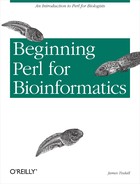As every biologist knows, mutation is a fundamental topic in biology. Mutations in DNA occur all the time in cells. Most of them don't affect the actions of proteins and are benign. Some of them do affect the proteins and may result in diseases such as cancer. Mutations can also lead to nonviable offspring that die during development; occasionally mutations can lead to evolutionary change. Many cells have very complex mechanisms to repair mutations.
Mutations in DNA can arise from radiation, chemical agents, replication errors, and other causes. We're going to model mutations as random events, using Perl's random number generator.
Randomization is a computer technique that crops up regularly in everyday programs, most commonly in cryptography, such as when you want to generate a hard-to-guess password. But it's also an important branch of algorithms: many of the fastest algorithms employ randomization.
Using randomization, it's possible to simulate and investigate the mechanisms of mutations in DNA and their effect upon the biological activity of their associated proteins. Simulation is a powerful tool for studying systems and predicting what they will do; randomization allows you to better simulate the "ordered chaos" of a biological system. The ability to simulate mutations with computer programs can aid in the study of evolution, disease, and basic cellular processes such as division and DNA repair mechanisms. Computer models of cell development and function, now in their early stages, will become much more accurate and useful in coming years, and mutation is a basic biological mechanism these models will incorporate.
From the standpoint of programming technique, as well as from the standpoint of modeling evolution, mutation, and disease, randomization is a powerful—and, luckily for us, easy-to-use—programming skill.
Here's a breakdown of what we will accomplish in this chapter:
Randomly select an index into an array and a position in a string: these are the basic tools for picking random locations in DNA (or other data)
Model mutation with random numbers by learning how to randomly select a nucleotide in DNA and then mutate it to some other (random) nucleotide
Use random numbers to generate DNA sequence data sets, which can be used to study the extent of randomness in actual genomes
Repeatedly mutate DNA to study the effect of mutations accumulating over time during evolution
A random number generator is a subroutine you can call. For most practical purposes, you needn't worry about what's inside it. The values you get for random numbers on the computer differ somewhat from the values of real-world random events as measured, for example, by detecting nuclear decay events. Some computers actually have devices such as geiger counters attached so as to have a source of truly random events. But I'd be willing to bet your computer doesn't. What you have in place of a geiger counter, is an algorithm called a random number generator.
The numbers that are output by random number generators are not really random; they are thus called pseudo-random numbers . A random number generator, being an algorithm, is predictable. A random number generator needs a seed , an input you can change to get a different series of (pseudo-)random numbers.
The numbers from a random number generator give an even distribution of values. This is one of the most important characteristics of randomness and largely justifies the use of these algorithms where some amount of random behavior is desired.
The other "take-home message" about random number generators is that the seed you start them up with should itself be selected randomly. If you seed with the same number every time, you'll get the same sequence of "random numbers" every time as well. (Not very random!) Try to pick a seed that has some randomness in it, such as a number calculated from some computer event that changes haphazardly over time.[1]
In the examples that follow, I use a simple method for seed picking that's okay for most purposes. If you use random numbers for data encryption with critical privacy issues (such as patient records), you should read further into the Perl documentation about the several advanced options Perl provides for random number generation.
[1] Even here, for critical applications, you're not out of the woods. Unless
you pick your seeds carefully, hackers will figure out how you're picking
them and crack your random numbers and therefore your passwords. The method
used to generate seeds in this chapter, time|$$, is crackable by dedicated hackers. A better choice
is time()
^
($$+<<15)). If program security is
important, you should consult the Perl documentation, and the
Math::Random and
Math::TrulyRandom modules from CPAN
